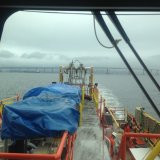Oil & Gas: Offshore Maintenance with Smart-glasses
 In 2019, a ship operator for the oil and gas industry contacted our team at eyllo to improve the reliability of their assets and increase maintenance efficiency.
For this project, my team and I worked with their operation and maintenance team to assess the requirements and plan the project.
For this pilot project, we demoed a software solution using smart-glasses to improve offshore maintenance.
In 2019, a ship operator for the oil and gas industry contacted our team at eyllo to improve the reliability of their assets and increase maintenance efficiency.
For this project, my team and I worked with their operation and maintenance team to assess the requirements and plan the project.
For this pilot project, we demoed a software solution using smart-glasses to improve offshore maintenance.
Background
The support vessels stay offshore for two weeks. At the end of the 2-week period, the vessels docks at a port in the morning and the crew onboard goes home. A new crew boards the ship, loads supplies, gets the ship ready to sail and moves the ship off the port, all this in less than 3 hours.
Contract maintenance personnel start performing light maintenance as soon as the ship docks. They remain onboard as the vessel leaves port and anchors, still in shallow water. As the sun sets, all contractors are transported off the ship and the ship starts sailing towards the oil basin, offshore.
Requirements and Limitations
Deploying a communication solution that works off-shore, on a ship, has some limitations beyond the ones commonly encountered when deploying the same solutions on-shore:
- Space is limited, even for a simple network or power cable. Moreover, one can’t just drill holes to pass cables.
- The amount of metal interferes with wi-fi, reducing the range. The satellite link adds lag.
Implementation
Together with the maintenance managers and reliability engineers, we decided to focus the project on improving the processes in the engine bay and propulsion systems. The engine bay lacked connectivity, so we installed an Access Point and connected this area with the satellite antennas.
We used our software solution Vista installed on smart-glasses and connected via satellite link to allow communication between on-board personnel and the maintenance support center onshore. Two different smart-glasses were tested: Epson’s Moverio BT-300 and RealWear’s hmt-1.
During the project, assisted maintenance was executed both during the day and at night, in order to validate the usefulness of the solution and processes. During theses operations, both smart-glasses were used in order to assess the suitability of user one or the other.
Results
The maintenance team was able to use the solution in order to improve troubleshooting and better prepare for the short time the ship spends on port. Using this approach, the engineers onshore could have a better understanding of the issues and the backlog, order the necessary supplies and better coordinate in advance with contractors the work that would be done during the short time the ship is on port.
